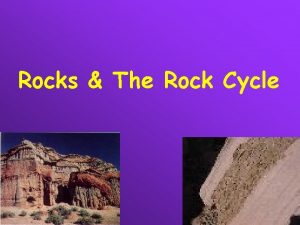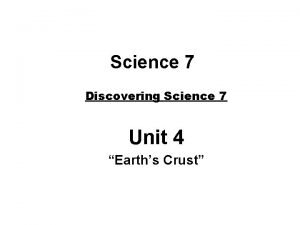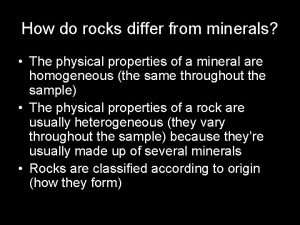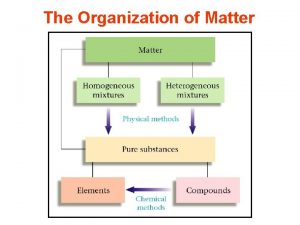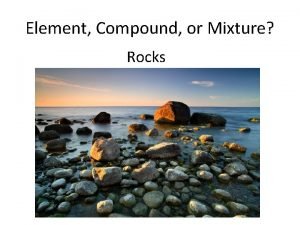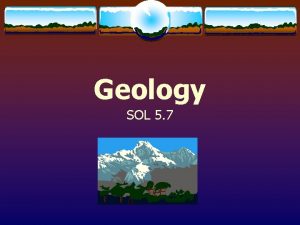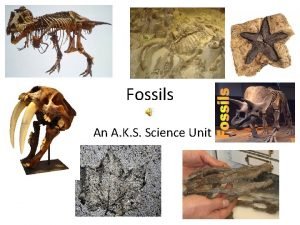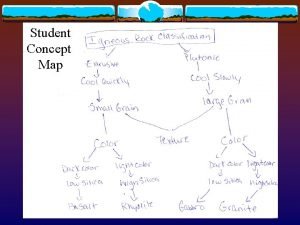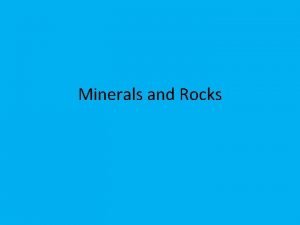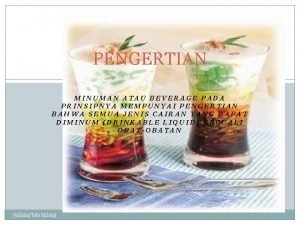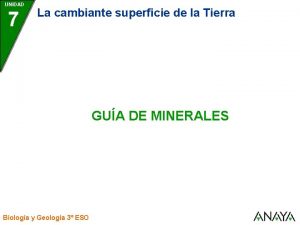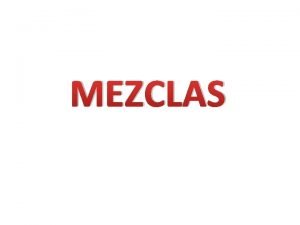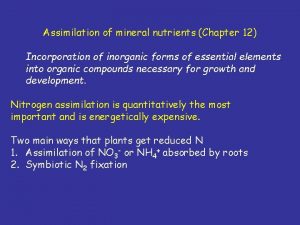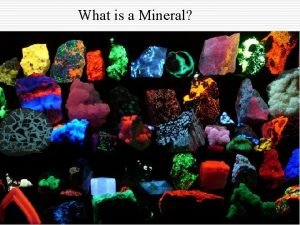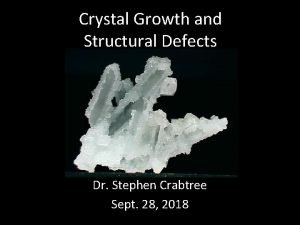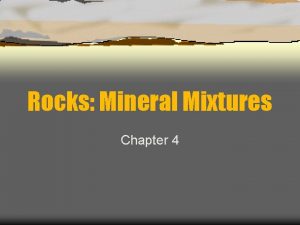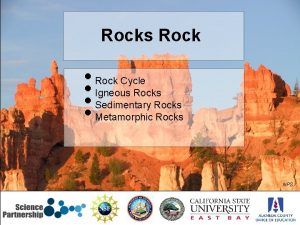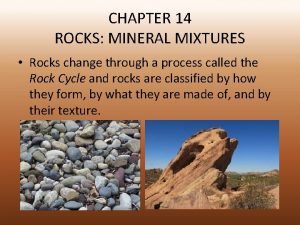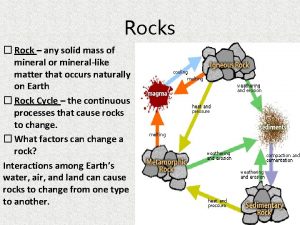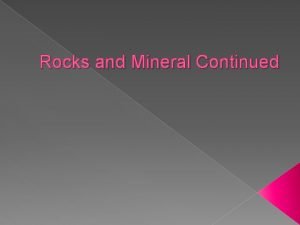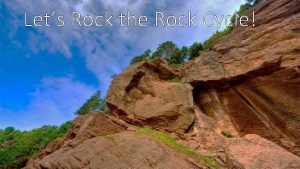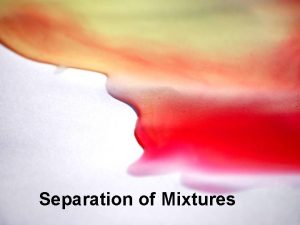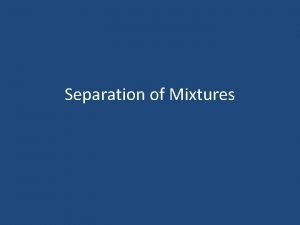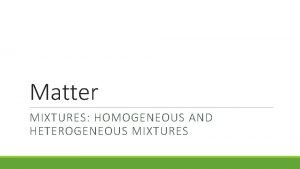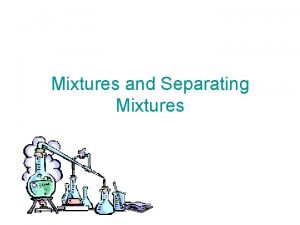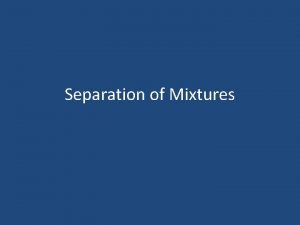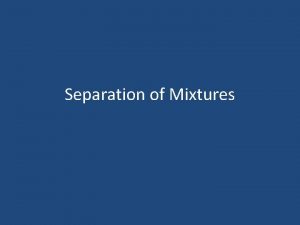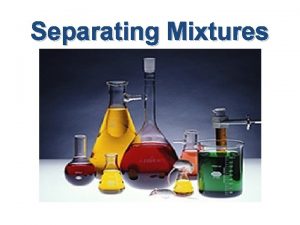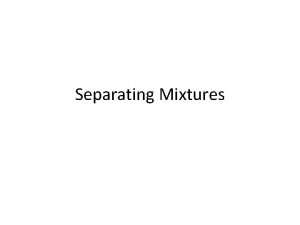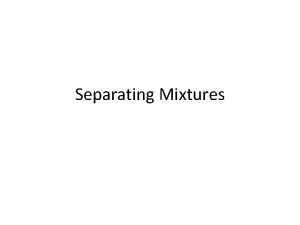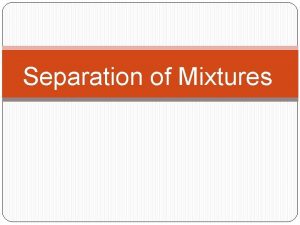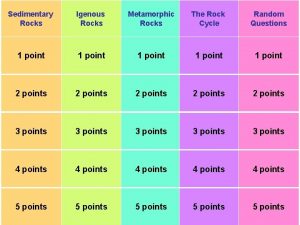Rocks Mineral mixtures Rocks n Rock A solid









































- Slides: 41

Rocks: Mineral mixtures

Rocks n Rock – A solid mixture of one or more minerals.

The Rock Cycle n The process by which one rock type changes into another. http: //www. learner. org/interactives/rockcycle/


Sedimentary Rocks n Rocks that form when sediments are compacted and cemented together.

Metamorphic Rocks n Rocks that forms when the texture and composition of a preexisting rock changes by heat and pressure produced deep within the Earth.

Igneous Rocks n Rocks that form from cooling of magma and lava both inside and on the surface of the Earth.

Composition n The minerals a rock is made of determines its composition. Example – Granite typically has 10% Biotitie Mica, 35% Quartz and 55% Feldspar. n However, there are classifications of Granites that have different amounts of each of these minerals. n

Composition cont.

Texture n The texture of a rock is determined by the sizes, shapes and positions of the grains which it is made of. Fine grained – silt or clay particles n Medium Grained – sand n Coarse Grained - pebbles n

Fine Grained Fine grained siltstone

Medium Grained Medium grained Sandstone

Coarse Grained Conglomerate

Igneous Rocks n n Rocks formed when magma and lava solidify Igneous comes from the Latin word for “fire”. Intrusive – igneous rocks from when magma cools below the Earth’s surface. n Extrusive – igneous rocks that form from lava cooling on the surface of the Earth n


n Intrusive, or plutonic, igneous rocks form when magma cools slowly below the Earth's surface. Most intrusive rocks have large, well-formed crystals. Examples include granite, gabbro, and diorite. Granite Gabbro Diorite

n Extrusive igneous rocks form when magma reaches the Earth's surface cooling quickly to form lava. Most extrusive (volcanic) rocks have small crystals. Examples include basalt, rhyolite, andesite. Basalt Rhyolite Andesite

Mafic Rocks n Mafic is used for silicate minerals, magmas, and rocks which are relatively high in the heavier elements. The term is derived from using the MA from magnesium and the FIC from the Latin word for iron. Mafic minerals are usually dark in color and have relatively high specific gravities

Felsic Rocks n Felsic, is used for silicate minerals, magmas, and rocks which have a lower percentage of the heavier elements, and are correspondingly enriched in the lighter elements, such as silica and oxygen, aluminum, and potassium. The term comes from FEL for feldspar and SIC, which indicates the higher percentage of silica.

n Intrusive igneous rocks are dense and hard and withstand weathering and erosion well.



Sedimentary rock Formation n Sedimentary rock – grains of sand sediment are eroded by weathering forming thick layers that are eventually cemented together. They are commonly formed on the ocean floor and other low areas. The most common rock found on the Earth’s surface

Weathering



Deposition

Forming the ocean floor

n Limestone rocks are sedimentary rocks that are made from the mineral calcite which came from the beds of evaporated seas and lakes and from sea animal shells. This rock is used in concrete and is an excellent building stone for humid regions.

n Conglomerate rocks are sedimentary rocks. They are made up of large sediments like sand pebbles. The sediment is so large that pressure alone cannot hold the rock together; it is also cemented together with dissolved minerals.

Grand Canyon

Painted Desert

Metamorphic Rocks n n n Metamorphic rocks are formed deep within the Earth. “Meta” in Latin means change. “Morph” in Latin means shape. Thus, metamorphic means a physical change to a rock caused by heat and pressure.

Contact Metamorphism n When surrounding rock comes in contact with magma but does not melt they often change to harder metamorphic type rocks.

n The lava flow exposed in this road cut near Alturas, California, has baked the mud beneath it into brick-red shale, a case of contact metamorphism.

Regional Metamorphism n Rocks that are typically altered in composition, texture, or internal structure by extreme heat and pressure over a large area during mountain formations or subduction.


Foliated Metamorphic Rocks n n n The generally-crude layering or foliation of many metamorphic rocks is due to the intense directional pressure they experience Usually along a convergent plate tectonic boundary. Flat mineral crystals and fragments gradually become oriented perpendicular to the directions of pressure.

Foliated rocks

More Foliated rocks

n jaspilite, which consists of alternating bands of red chert (jasper; cryptocrystalline quartz - Si. O 2), red hematite (iron oxide - Fe 2 O 3), and silvery-gray specular hematite (iron oxide Fe 2 O 3). Chert
 Can igneous rocks form metamorphic rocks
Can igneous rocks form metamorphic rocks Igneous metamorphic and sedimentary
Igneous metamorphic and sedimentary Minerals vs rocks
Minerals vs rocks Rock vs mineral
Rock vs mineral Rock vs mineral
Rock vs mineral Nejměkčí nerost
Nejměkčí nerost Filtration of sand and salt
Filtration of sand and salt Are rocks an element compound or mixture
Are rocks an element compound or mixture A rock climber's shoe loosens a rock and her climbing buddy
A rock climber's shoe loosens a rock and her climbing buddy Rock cycle sedimentary
Rock cycle sedimentary Rock cycle image
Rock cycle image Extreme sports bungee jumping
Extreme sports bungee jumping Chapter 3 standardized test practice answers
Chapter 3 standardized test practice answers Lynette lin
Lynette lin Asus slogan
Asus slogan Admixtures
Admixtures Solid rock cycles
Solid rock cycles Shallow print or mark in solid rock
Shallow print or mark in solid rock Difference between rocks and minerals
Difference between rocks and minerals Amorphous vs crystalline
Amorphous vs crystalline Crystalline solids
Crystalline solids Interpenetration of surfaces
Interpenetration of surfaces Solution example
Solution example Crystalline solid and amorphous solid
Crystalline solid and amorphous solid Separation example
Separation example Covalent molecular and covalent network
Covalent molecular and covalent network Anisotropic meaning in chemistry
Anisotropic meaning in chemistry Example of crystalline solid
Example of crystalline solid When a solid completely penetrates another solid
When a solid completely penetrates another solid Types of rock concept map
Types of rock concept map Concept map of igneous rock
Concept map of igneous rock Extrusive vs intrusive igneous rocks
Extrusive vs intrusive igneous rocks Volcanic rocks and plutonic rocks
Volcanic rocks and plutonic rocks Mica hardness
Mica hardness 5 characteristics of minerals
5 characteristics of minerals Chapter 13 mineral resources and mining worksheet answers
Chapter 13 mineral resources and mining worksheet answers Materi beverage
Materi beverage Oxidos minerales ejemplos
Oxidos minerales ejemplos El agua mineral es disoluciones coloides o suspensiones
El agua mineral es disoluciones coloides o suspensiones Plant name
Plant name Luster mineral
Luster mineral Twin
Twin


